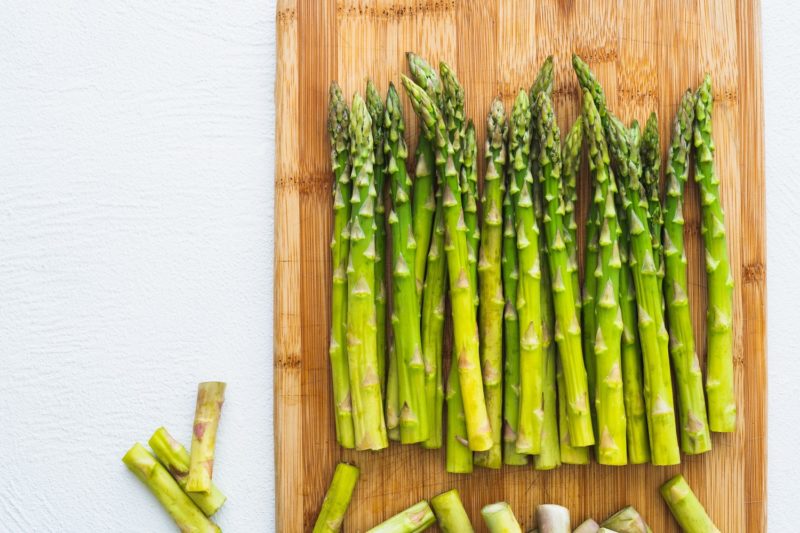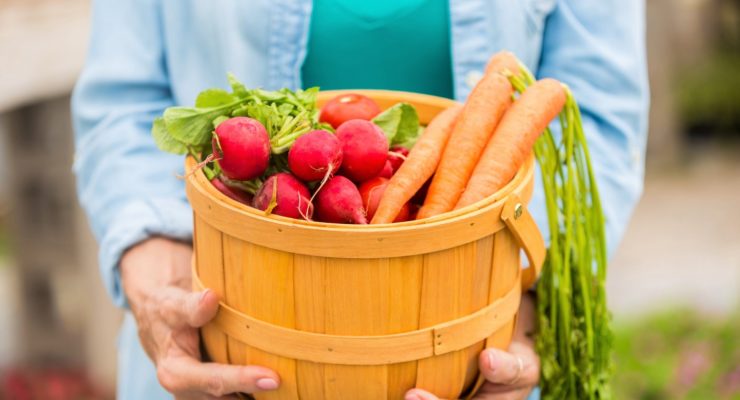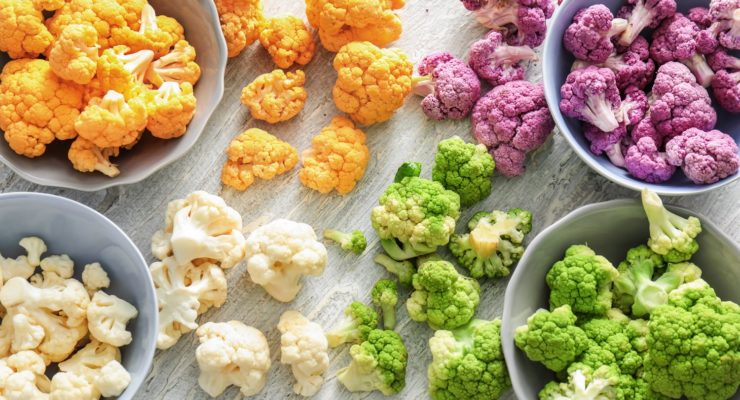8 Seasonal Spring Foods to Stock Up On
Article posted in: Diet & Nutrition
When the days grow longer and warmer, we all feel better. Not only do we get to enjoy more fresh air and sunshine but we also find an abundance of deliciously healthy spring foods in grocery stores and farmers markets. These seasonal fruits and vegetables can be the foundation of Flex meals that the whole family will love. To help you choose and use the bounty of spring, we’ve gathered this list of eight exceptional in-season produce options, plus some tempting ways to eat them.
1. Artichokes

Artichokes are the flower buds from thistle plants. Their tough, spiny outer petals enclose smaller petals that are full of soft pulp and a tender “heart” attached to the stem. You may find purplish varieties as well as the more common dark green types. While canned artichoke hearts are available in stores year-round, spring is prime time for the fresh buds.
Nutritional highlights: According to the United States Department of Agriculture (USDA), a half-cup of cooked artichokes has about 71 calories, 2.45 grams of protein and almost 5 grams of fiber. The fiber includes inulin, a compound that has been linked to an increase in good cholesterol (HDL) and a decrease in the unhealthy kind of cholesterol (LDL), according to a report in the journal Pharmacological Research.
Tasty ideas: Fresh artichokes need to be cooked—usually steamed or boiled—before you eat them. This isn’t hard once you know how, as you can see from our simple guide to cooking artichokes. Many people enjoy the tender inner leaves dipped in butter, mayonnaise or another fat-laden dip. Skip those and make yourself a better option by blending herbs such as thyme and tarragon into plain, fat-free Greek yogurt. Slow Cooker Artichoke Chicken with Potatoes and Sundried Tomatoes is an easy-to-make yet satisfying Flex meal that feature one of our favorite spring foods.
2. Arugula


This peppery-flavored leafy green is in the same family as broccoli, cabbage and kale. Sometimes sold as rucola, salad rocket and Italian cress, arugula (say it, “ah-RUE-gah-lah”) looks a bit like dandelion leaves, which have a similar taste. If you like to garden, arugula is very easy to grow from seeds in the ground or a container and it thrives in early spring, when nighttime temperatures are still cool.
Nutritional highlights: Like most leafy green vegetables, arugula is a good source of vitamin A, a nutrient that helps keep your immune system strong. According to the USDA, a half-cup of the greens has about 37 milligrams of potassium, which your body needs to manage its sodium levels. Glucosinolates, the natural compounds that give arugula its zesty flavor, appear to help protect against cancers of the gastrointestinal tract, says a report in the journal Phytochemistry Review.
Tasty ideas: Arugula is typically eaten raw in salads, sandwiches and wraps. Add a little zing of flavor to any Nutrisystem flatbread or pizza (such as the Thick Crust Pizza) by chopping up arugula leaves and sprinkling them on top when the meals come out of the oven. Our Arugula Beet Salad with Orange Slices features another one of our favorite spring foods and treats your taste buds to spicy, sweet and acidic flavors in every bite.
3. Asparagus


Fresh asparagus spears are one of the sure signs that spring foods have arrived. When they’ve been recently picked, they are juicy and taste lightly sweet with just a hint of earthiness. When shopping for asparagus, be sure to choose spears with tight flower buds at the top—they start to open up after they’ve been sitting out too long. Thinner spears are more tender than big, thick ones.
Nutritional highlights: Another good source of vitamin A and potassium, a half-cup of cooked asparagus clocks in around 83 calories, says the USDA. (You may notice a distinctive odor when your body is flushing fluids after you eat asparagus—it’s no cause for alarm, just the by-product of the sulfur content in the vegetable.) Anthocyanin, another micronutrient in asparagus, is linked to lower blood pressure, say researchers in a report, published in the American Journal of Clinical Nutrition.
Tasty ideas: Raw asparagus is too tough to chew, but after brief steaming the spears become tender and sweet. They work well as a vegetable for dipping if you blanch them (boiled quickly and then plunged into cold water), which keeps the stalks firm but easy to chew. Roasting or grilling softens asparagus spears and brings out more flavor. We like them in our recipe for Grilled Asparagus Caesar Salad.
4. Beets


Beets are a raw ingredient in the making of processed white sugar and they taste naturally sweet. However, when eaten in their whole form they actually rank low to medium on the glycemic index, which means they won’t cause unhealthy spikes in your body’s glucose levels. The purplish red roots are most familiar, but in spring you will find striped varieties and some that are golden yellow-orange. And don’t throw away the leafy greens on top—they can be eaten raw in salads or sautéed like spinach.
Nutritional highlights: A half-cup of cooked sliced beets has around 37 calories and 1.7 grams of fiber. They also contain folate and beta carotene, among other vitamins and minerals, says the USDA. Beets get their color from polyphenols, the same compounds in red wine that help protect your heart and reduce your risk of high blood pressure. Research, published in Hypertension, found that blood pressure was reduced for up to four hours in people who consumed beet juice.
Tasty ideas: Roasting and grilling enhances the sweet flavor of beets. They can also be steamed or simply boiled to tenderize them. Beets are an ideal companion to goat cheese in one of our favorite party treats, Beet and Goat Cheese Appetizers. You and your family will love our Healthy Red Velvet Brownies, but only you will know you made them with beets.
5. Mushrooms


While you may find many kinds of mushrooms in stores year-round, the variety that chefs and other foodies say taste best—morels—are available fresh primarily in spring. You are most likely to find morels in farmer’s markets and specialty stores. If you enjoy spending time in the outdoors, you might join a local group of mushroom hunters and pick your own—look for these groups on social media and do your research before picking wild mushrooms.
Nutritional highlights: All types of mushrooms add a meaty flavor and texture to many dishes, but they don’t come with the saturated fats and excess calories you typically get with beef or pork. Mushrooms are a good food source of vitamin D, which plays an important role in managing your appetite. Overweight people who regularly eat mushrooms may reduce their body mass index (BMI) and waist size, according to a study, published in the journal Molecules.
Tasty ideas: Try slices of white or button mushrooms raw in salads. Add sautéed mushrooms (hold the butter and use a little olive oil spray instead) to grilled chicken or fish. Start your day with a hearty, hot meal—including one of your four daily servings of veggies—with 4-Ingredient Mushroom Caps. Our Lettuce Wrapped Mushroom and Swiss Burger is a Flex meal that will fill you up without weighing you down.
6. Rhubarb


Ruby-red stalks of the rhubarb plant show up on produce shelves and at farmers markets in early spring and are almost always gone by the start of summer. It’s another easy plant to grow in a garden and it’s a perennial, which means you plant it once and comes back year after year. Rhubarb has a strongly tart flavor so it needs to be combined with other ingredients to be palatable.
Nutritional highlights: According to the USDA, rhubarb contains fiber and is a rich vegetable source of calcium and vitamin K, a nutrient that helps protect your bones as you age. It also contains catechins, a micronutrient that is abundant in green tea, too. These compounds are associated with lower BMI and overall body fat, says a report in the American Journal of Clinical Nutrition.
Tasty ideas: Rhubarb, sometimes called “pie plant” is most commonly used to add a tangy flavor to sweet baked goods, such as muffins, scones and pies. When slow-cooked into a thick sauce called “compote,” rhubarb works as a tasty addition to plain fat-free yogurt or oatmeal. It also makes a deliciously rich sauce for grilled chicken or fish. If you want to enjoy the classic combination of strawberries and rhubarb while staying on track to your weight loss goal, try our Skinny Strawberry Rhubarb Crumble.
7. Spinach


This leafy green is one of the most nutrient-dense spring foods, which means it’s packed with vitamins and minerals but low in calories. In spring, you can find big heads of fresh spinach as well as the “baby” leaves. When fresh, spinach is dark green with firm stems and no yellow or brown spots. Don’t wash the leaves until you’re ready to eat them—lingering moisture can cause them to begin to rot.
Nutritional highlights: A cup of raw spinach has just under six calories, says the USDA. It’s also rich in vitamin A and contains calcium and vitamin C. A research report, published in the Journal of the American College of Nutrition, concluded that when study subjects ate spinach as part of a meal, they were not hungry for more than two hours later.
Tasty ideas: The immature leaves commonly sold as “baby spinach” are best for eating raw in salads, sandwiches and wraps. You can use them or the large, firmer leaves in omelets, stir-fries or pasta. An Apple Spinach Smoothie is a sweet and filling way to get spinach into your diet first thing in the morning. Spinach dip is a popular party snack—our “skinny” version has all of the flavor you love but with far fewer calories than the traditional recipe.
8. Strawberries


If you’ve only ever eaten the big, waxy strawberries sold in supermarkets year-round, you need to take a bite of the sweet, juicy fruit that’s available fresh-picked only in spring. Local strawberries don’t last long—from Mother’s Day to Father’s Day in most of the U.S.—but they are a seasonal treat worth seeking out.
Nutritional highlights: Strawberries are naturally sweet, but they’re a SmartCarb because they’re low in calories—just 48 in a 1 cup serving—and they are high in fiber. According to the USDA, they also contain vitamin C, a powerful nutrient for your immune system. Strawberries also are associated with a lower risk of diabetes and metabolic syndrome (the conditions that often lead to diabetes), according to a report, published in the Journal of Agricultural Food Chemistry.
Tasty ideas: Fresh strawberries are so irresistible, they make a satisfying dessert or snack all by themselves. You can slice them up and add them to a salad that’s filled with spring foods, such as our Strawberry Feta Spinach Salad. Whip them with plain fat-free Greek yogurt to make 2-Ingredient Strawberry Froyo. Treat the whole family to a special dessert with Cannoli Stuffed Strawberries, made with real ricotta cheese and mini chocolate chips.
Looking for some delicious ways to enjoy these spring foods? Explore the Recipe Section on The Leaf!
Do you have your own seasonal recipe that features one of these spring foods? Submit your ideas on our Recipe Submission page!










